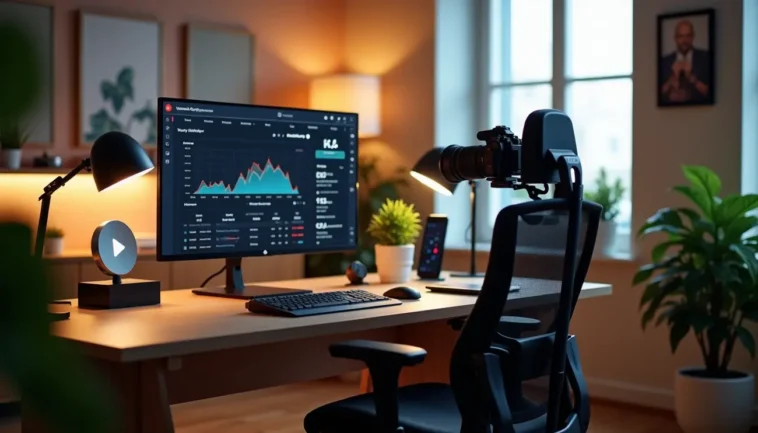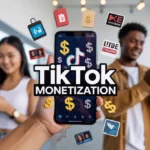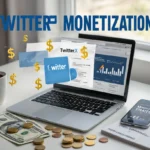YouTube monetization represents a significant opportunity for content creators like us to turn our passion into income. However, before you can start earning, you need to meet specific requirements. As of 2025, YouTube has established clear thresholds that include subscriber counts, watch hours, and Shorts views, along with other eligibility criteria such as your location and content originality.
Specifically, the YouTube monetization policy now features two tiers. To fully access ad revenue, you need 1,000 subscribers AND either 4,000 valid public watch hours in the past 12 months OR 10 million Shorts views in the last 90 days. Additionally, there’s an early access tier requiring 500 subscribers with either 3,000 watch hours or 3 million Shorts views.
Being accepted into the YouTube Partner Program is a major milestone for any creator’s journey. Fortunately, in this guide, we’ll walk you through everything you need to know about how to get monetized on YouTube in 2026 — from setting up your channel correctly to growing your audience and ultimately receiving your first paycheck.
Understand YouTube Monetization Requirements for 2026
YouTube’s monetization system in 2026 operates on a two-tier structure, making it more accessible for creators at different stages of their journey. Let’s break down exactly what you need to qualify for each tier and what benefits they offer.
Tier 1: 500 subscribers + 3,000 watch hours or 3M Shorts views
The entry-level monetization tier represents YouTube’s effort to help smaller creators start earning sooner. To qualify for this early access tier, you must meet three key requirements:
- Achieve 500 subscribers on your channel
- Upload at least 3 public videos within the past 90 days
- Reach either 3,000 watch hours from long-form videos in the past 12 months OR 3 million Shorts views in the past 90 days
Once you reach these thresholds, you’ll unlock access to several revenue opportunities, although not the full suite of monetization tools. What’s particularly valuable about this tier is that it allows creators to start generating income while still growing their audience.
Tier 2: 1,000 subscribers + 4,000 watch hours or 10M Shorts views
For full monetization privileges, including ad revenue sharing, you’ll need to meet higher thresholds:
- Reach 1,000 subscribers
- Accumulate either 4,000 valid public watch hours from long-form videos in the past 12 months OR 10 million valid public Shorts views in the past 90 days[53]
YouTube is strict about what counts toward these requirements. For watch hours, only views from public long-form videos contribute—not private videos, unlisted content, deleted videos, ad campaigns, or Shorts views. For Shorts, only engaged views from public Shorts appearing in the Shorts Feed count.
Differences between early access and full youtube monetization
The distinction between these tiers lies primarily in the revenue streams available:
Tier 1 (Early Access) Benefits:
- Access to fan funding features including Super Thanks, Super Chat, and Super Stickers
- Channel memberships for subscriber-only perks
- YouTube Shopping integration
Tier 2 (Full Monetization) Benefits:
- All Tier 1 benefits
- Ad revenue sharing from both long-form videos and Shorts
- YouTube Premium revenue sharing[82]
Notably, ad revenue represents the most significant income source for most creators. While Tier 1 creators can earn through direct fan support, they cannot access ad revenue until reaching the Tier 2 thresholds.
For Shorts monetization at Tier 2, YouTube uses a unique revenue-sharing model. The platform pools all Shorts ad revenue, allocates portions based on each creator’s share of total views, and then splits this 45/55—with creators receiving 45% of their allocated portion.
Worth mentioning, if your content includes music, a portion of your Shorts revenue goes to music publishers. The earnings potential varies significantly between Shorts and long-form content—Shorts typically generate $0.01-$0.06 per 1,000 views, whereas long-form videos average $1.25-$2.50 per 1,000 views.
Remember that meeting these numerical thresholds doesn’t guarantee automatic acceptance. All channels undergo a standard review process to ensure compliance with YouTube’s monetization policies, including originality requirements and community guidelines.
Set Up Your Channel for Monetization
Once you’ve reached the necessary subscriber and watch time thresholds, your next challenge is setting up the technical aspects of your channel for monetization. These requirements are equally important and must be completed before YouTube will consider your application.
Create and link a Google AdSense account
AdSense is the system that enables YouTube to pay you, making it an essential part of the monetization process. Creating and linking an AdSense account is straightforward and takes approximately 10 minutes. I recommend completing this step even before you meet the subscriber and watch time requirements.
To set up AdSense:
- Navigate to the “Monetization” tab in YouTube Studio
- When prompted, select “Start” on the “Sign up for Google AdSense” card
- Choose whether you have an existing account or need to create a new one
- If creating a new account, provide your contact information accurately
Remember that you can only have one AdSense account per payee name. Furthermore, if you operate multiple YouTube channels, you can link them all to a single AdSense account for centralized payment management.
Enable two-factor authentication
Two-factor authentication (2FA) adds crucial security to your channel and is mandatory for YouTube monetization. This feature prevents unauthorized access even if someone obtains your password.
To enable 2FA:
- Go to your Google Account settings
- Select “Security” from the menu
- Under “How you sign in to Google,” select “Turn on 2-Step Verification”
- Follow the on-screen prompts to complete setup
YouTube provides several 2FA options, including Google prompts (recommended for security against SIM swap attacks), authentication apps, backup codes, or text message verification. Choose the method that balances convenience with security for your situation.
Check country eligibility for YouTube Partner Program
As of 2025, the YouTube Partner Program operates in more than 120 countries worldwide. Consequently, your geographical location directly affects your eligibility for monetization.
Major eligible regions include:
- North America (United States, Canada, Mexico)
- Most European countries
- Many Asian countries including Japan, India, and South Korea
- Australia and New Zealand
- Various countries across South America, Africa and the Middle East
The complete list includes over 120 countries, from Algeria to Zimbabwe. If your country isn’t eligible, unfortunately, you cannot apply for monetization regardless of meeting other requirements.
Upon completing these three technical prerequisites—linking AdSense, enabling 2FA, and confirming country eligibility—alongside meeting the subscriber and watch time thresholds, you’ll be ready to submit your application to the YouTube Partner Program. The application process itself includes a thorough review to ensure your channel meets all community guidelines and monetization policies.
Follow YouTube Monetization Policies
Meeting YouTube’s technical requirements is only half the battle in your monetization journey. Indeed, complying with YouTube’s content policies is often the more challenging obstacle many creators face when applying for the YouTube Partner Program.
Avoid copyright violations and reused content
Copyright violations occur when you use someone else’s original content without proper permission or license. YouTube employs sophisticated Content ID technology that automatically flags uploaded videos containing copyrighted material. If identified, copyright owners can choose to monetize your video, block it entirely, or simply track its viewership statistics.
For new creators, understanding “reused content” is particularly crucial. This refers to content that’s repurposed from other sources without adding significant original value. According to YouTube’s policies, your application will likely be rejected if your channel contains substantial reused content. Common examples include:
- Simple compilations of clips from other creators without meaningful commentary
- Re-uploading others’ videos with minimal changes
- Content generated through automated tools or templates
- Similar, repetitive videos without unique value-add elements
To avoid these issues, focus on creating truly original content where your unique voice, perspective, or creative effort is clearly visible. When using third-party material, make it transformative by adding substantial commentary, analysis, or educational context.
Stay within community guidelines
YouTube’s Community Guidelines form the foundation of acceptable content on the platform. These rules apply universally—regardless of your geographical location, political viewpoint, or channel size.
Violations are identified through a combination of automated systems and human reviewers. The consequences follow a structured approach:
First violation: Warning with no penalty Second violation: One-week restriction on uploading content Third violation: Channel termination if three strikes occur within 90 days
More serious violations can result in immediate channel termination, bypassing the strike system completely. The guidelines primarily protect against harmful content including hate speech, dangerous behaviors, harassment, misinformation, and sexually explicit material.
Understand advertiser-friendly content rules
For monetization purposes, merely avoiding guideline violations isn’t enough—your content must also be “advertiser-friendly.” This means creating videos that brands feel comfortable associating with their products.
YouTube’s advertiser-friendly guidelines cover sensitive topics that might limit your ad revenue. These include:
- Violence or disturbing content
- Adult or sexual content
- Harmful or dangerous acts
- Hateful or derogatory content
- Recreational drug-related content
- Tobacco and firearms-related content
- Controversial issues and sensitive events
Context matters immensely in these evaluations. Content with clear educational, documentary, scientific, or artistic (EDSA) value may receive exceptions. To maximize monetization potential, avoid excessive profanity (especially in the first 30 seconds), keep thumbnails and titles clean, and steer clear of shocking or inflammatory content.
Throughout your monetization journey, remember that YouTube continuously reviews channels in the Partner Program. In other words, maintaining policy compliance is an ongoing requirement rather than a one-time hurdle. By creating original, guideline-compliant, and advertiser-friendly content from the start, you’ll establish a sustainable foundation for long-term monetization success.
Grow Your Channel to Meet Youtube Monetization Thresholds
Growing a YouTube channel to reach monetization thresholds requires strategic planning and understanding what works best for your content style. After examining YouTube’s requirements, let’s explore the most effective ways to build your audience and watch time.
Focus on long-form vs Shorts: which is better for you?
The decision between focusing on long-form content or Shorts significantly impacts your monetization journey. Based on creator experiences, long-form videos consistently generate higher revenue per thousand views (RPM) – typically between $3.00 and $6.00 compared to Shorts’ meager $0.15-$0.30. Moreover, YouTube Shorts views don’t contribute to the 4,000 watch hours requirement.
Nevertheless, Shorts offer tremendous visibility benefits. With over 50 billion daily views, Shorts can dramatically accelerate subscriber growth. Creators using both formats see a 40% increase in overall subscriber growth. Hence, a balanced approach might work best: 60% long-form videos for revenue and watch time, with 30% Shorts for audience expansion.
Tips to get your first 1,000 subscribers
To reach that crucial 1,000 subscriber milestone:
- Create evergreen content that remains relevant and searchable long-term
- Optimize your channel page, as it’s often a top source of new subscribers
- Strengthen existing content with improved thumbnails rather than always creating new videos
- Time your call-to-action strategically – viewers who watch until the end are most likely to subscribe
- Collaborate with complementary creators to share audiences
- Reply to every comment to build community engagement
How to increase watch time with engaging content
Watch time accumulation requires keeping viewers engaged throughout your videos. Start with compelling hooks in the first 15 seconds. Subsequently, maintain viewer interest by trimming slower sections and creating emotional connections through relatable storytelling.
For maximizing watch time, consider creating serialized content where viewers want to watch multiple videos in succession. Additionally, livestreaming counts toward watch time requirements and builds deeper audience connections. Playlists automatically play your next video, further increasing session duration.
Avoid common mistakes that slow down growth
Several common pitfalls can derail your monetization journey. Primary among these is launching without a content plan – successful creators often spend months planning strategic content. Likewise, going too broad with your audience dilutes your message; narrow your focus to reach viewers more effectively.
Other growth-killing mistakes include inconsistent publishing (aim for at least weekly uploads), obsessing over equipment instead of content quality, and ignoring analytics data that could guide your content decisions. Finally, avoid perfectionism – your first videos won’t be perfect, but you need to start publishing to gain momentum and feedback.
What Happens After You Apply for Monetization
The application process marks a pivotal moment in your YouTube journey. After submitting your monetization application, a whole new phase begins – one that requires patience and sometimes persistence.
How long YouTube takes to review your channel
Upon submission, your channel enters a review queue where both automated systems and human reviewers evaluate your content. Typically, YouTube completes this process within 30 days. Many channels receive decisions within 1-2 weeks, though some may take the full month. During this evaluation period, reviewers assess:
- Your channel’s main theme
- Most viewed videos
- Newest content
- Videos with highest watch time
- Metadata including titles and thumbnails
Several factors might extend this timeline, such as high application volumes, system issues, or resource limitations. Additionally, channels requiring multiple reviews due to disagreement among reviewers often experience longer wait times.
What to do if your application is rejected
Facing rejection initially feels disappointing, yet it’s rarely the end of your monetization journey. If denied, first examine the specific reason provided in YouTube’s notification. Common reasons include copyright issues, reused content, or community guideline violations.
For rejected applications, you have two options:
- Submit an appeal within 21 days (YouTube responds within 14 days)
- Make necessary improvements and reapply after 30 days
For subsequent rejections, the waiting period extends to 90 days before you can try again. Instead of giving up, use this time to analyze your content, remove problematic videos, and create fresh, original material that better aligns with YouTube’s policies.
How to stay eligible and keep earning
Once approved, maintaining your monetization status requires ongoing vigilance. YouTube regularly reviews monetized channels to ensure continued compliance. To preserve your earning abilities:
- Remain active by uploading videos at least once every 6 months
- Consistently follow community guidelines and monetization policies
- Create original content rather than repurposed material
- Ensure your content remains advertiser-friendly
Remember that YouTube may limit or remove monetization features if you violate policies. Furthermore, they can withhold earnings associated with policy violations, making continuous compliance essential for sustainable income.
Conclusion
YouTube monetization represents an achievable goal for content creators willing to put in consistent effort. Throughout this guide, we’ve covered every essential aspect of qualifying for the YouTube Partner Program in 2026, from meeting basic requirements to receiving your first payment.
The two-tier system now offers creators multiple paths to monetization. Whether you focus on long-form content for higher revenue potential or leverage Shorts for rapid audience growth, both approaches can lead to success when executed strategically.
Remember that technical setup matters just as much as subscriber counts. Your AdSense account, two-factor authentication, and country eligibility all play crucial roles in your application. Similarly, adherence to copyright rules, community guidelines, and advertiser-friendly policies determines your long-term sustainability on the platform.
Most creators face challenges during their monetization journey. Patience becomes your greatest ally, especially during the application review process. Rejection doesn’t signal the end – rather, it presents an opportunity to refine your approach and try again.
The creators who ultimately succeed share common traits: they create original content, maintain consistency, analyze their performance data, and adapt their strategies accordingly. Your first videos might not perform perfectly, but each upload brings valuable lessons that improve your future content.
YouTube monetization transforms passion into potential income, but this transformation rarely happens overnight. The platform rewards creators who deliver genuine value to viewers while respecting its established guidelines. Start your journey with realistic expectations, celebrate small milestones along the way, and you’ll eventually build a sustainable channel that meets all monetization requirements.
FAQs
Q1. What are the new YouTube monetization requirements for 2026? YouTube has introduced a two-tier system for monetization. Tier 1 requires 500 subscribers and either 3,000 watch hours or 3 million Shorts views. Tier 2 requires 1,000 subscribers and either 4,000 watch hours or 10 million Shorts views.
Q2. How can I grow my YouTube channel to meet monetization thresholds? Focus on creating high-quality, original content consistently. Optimize your video titles, descriptions, and thumbnails. Engage with your audience through comments and community posts. Consider using a mix of long-form videos and Shorts to maximize growth potential.
Q3. What types of content are not eligible for YouTube monetization? Content that violates copyright laws, reused content without significant original input, content that goes against community guidelines, and non-advertiser-friendly material are typically not eligible for monetization.
Q4. How long does the YouTube monetization review process take? The review process usually takes about 30 days, though some channels may receive a decision within 1-2 weeks. Factors like high application volumes or the need for multiple reviews can extend this timeline.
Q5. What should I do if my monetization application is rejected? If your application is rejected, carefully review the reason provided by YouTube. You can either appeal the decision within 21 days or make necessary improvements to your content and reapply after 30 days. Use this time to analyze your content and ensure it aligns with YouTube’s policies.





GIPHY App Key not set. Please check settings